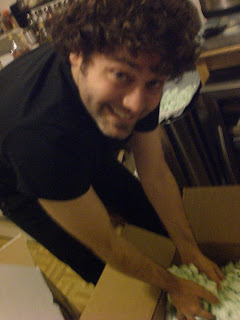The first and MOST important part to any at-home wine making venture is the sanitization process. (This may seem obvious – especially considering the fact that this tiny apartment contains a not so tiny amount of pets…so anyone out there reading this that might at a later date consume this wine should know…we took sanitization seriously). Now the thing to keep in mind, or so we’ve been told repeatedly, is to use a sanitizer that will not adversely affect the flavor of the wine.
The most commonly used cleaning agent is either sodium metabisulphite (a mouthful, I know) powder or Campden tablets that you dissolve in water. We went for the powder version that we mixed and poured into a never-been-used spritzer bottle.
In the video we watched, the lovely couple in their lovely home cleans everything in their lovely (and quite large) sink in their lovely kitchen. Now our entire apartment could probably fit in the kitchen they are using…and the 10 gallon plastic primary fermenter will most definitely not come close to fitting into our kitchen sink. So it’s off to the bathtub we go.
(On a side note, I would like to mention that I do find it hilarious that we are now making what I like to refer to as a “bathtub pinot.”)
We started by rinsing everything with water and then spritzed it with the metabisulphite mixture…rinse and repeat, people…rinse and repeat.
The next step was to mark the primary fermenter container off at the 23 liter mark (that’s roughly 6 gallons for all the non-metric types). To do this, we took a quick lesson in siphoning. This is more for us to try out siphoning techniques so when the racking time comes we are not complete novices.
So we fill the glass carboy up until about 2 finger widths from the top, insert the plastic tubing and Justin begins to suck. (Insert joke here.) All it takes is a little to get going and the next thing we know. Voilá. The water is siphoning from the carboy to the primary fermenter.
Once the all the water is in the primary fermenter, we took a Sharpie® and marked off the level of the water…which turned out to be almost exactly at the 23 liter mark. (It also turned out that our fermenter had the liters marked off on the other side, but we were too intent on following the directions to the letter that we didn't notice this until after the fact.)
Once the 23 liter marking is finished, we poured the water out of the primary fermenter. Rinsed, spritzed and rinsed (for good measure). And then off to begin the magic.
We boiled 2 liters of water on the stove and added it to the primary fermenter. Then Justin slowly sprinkled the bentonite into the water. Then he stirred for about 30 seconds to ensure even dispersal of the bentonite and to break up any clumps that might have formed.
Finally, we get to break open the juice box. The box turned into a rather nice pouring device, and then we just popped the top and poured the juice into the fermenter with the bentonite solution. We then added some warm water to the juice bag and swirled it about to get any leftover wine juice out of the bag and into the fermenter.
Then we added spring water to the fermenter until it reached the 23 liter mark. Now, I would like to mention that at this point in the video they bring out a stirring spoon, but then tell you a better way to mix the wine solution is with a DRILL powered mixer. I bring this up simply to point out that I’ve never known I needed this until now…but I NEED a drill powered mixer for no other reason that it looks like it would be so much fun to use. I guess there’s always next time…I digress.
Justin then began to stir as vigorously as possible to make sure the juice, water and bentonite got completely mixed together – mixing wine juice and water is almost equivalent to mixing water and oil, needless to say, it takes some muscle to fully mix the two.
Then, using a turkey baster, we drew a sample of the soon-to-be wine and used a hydrometer to test the specific gravity. We are told that it should read between 1.080 and 1.100. Ours read at 1.085 – Success!
We then added the oak chips to give our eventual pinot noir a smoky flavor. Then we stuck the thermometer onto the side of the fermenter and waited. Once the thermometer read between 18-24 degrees C, we got to add the yeast.
Fermentation will begin within 24-48 hours…and we will see you in a week.
Let The Winemaking Commence…
Posted by Justin + Lauren at 3:11 PM
In the Beginning...
There was wine.
Actually, there was a boy named Justin, a girl named Lauren and a large box of wine making items that came in the mail.
This is the beginning of our humble attempt to make a drinkable, if not decent bit of wine...in a 475 sq ft apartment in New York City's El Barrio.
We've opened the boxes, watched the videos, read the pamphlets and will begin washing everything in the bathtub in the very near future.
(And you did hear right, the bathtub. Intrigued? Justin, a six-gallon carboy and a bathtub...what hijinks could ensue? We'll have to wait and see.)
Posted by Justin + Lauren at 1:54 PM
Subscribe to:
Comments (Atom)







